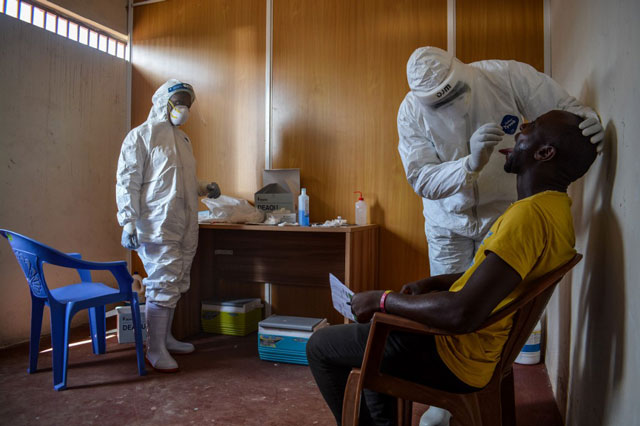
Stages in COVID-19 transmission
There are four distinct phases of infection intensity for the coronavirus with increasing possibility of exposure of a susceptible persons at each stage.
The first are sporadic cases (isolated cases primarily from persons known to have recently travelled, with the population at risk largely limited to contacts with the cases).
The second is local transmission (additional cases from persons who can be traced to known cases, with the population at risk being the networks to which the cases belong).
Three are clustered community transmission (additional cases are from persons who cannot be traced to known cases, but are within a definable cluster, such as a city, slum or large event, with possible exponential increases in cases within the clusters; the population at risk is the persons in the cluster to which the cases belong).
Finally is the widespread sustained community transmission (additional cases are from multiple, unconnected clusters and self-propagating with exponential increases of cases across these many clusters, with the population at risk being most of the population of the country).
For now, Uganda appears to be in the first stage. But intensity and severity of rate of infections, hospitalization, and deaths could change dramatically if the situation gets to stage four.
That Uganda has by this time not registered a single death could partly explain the nonchalance. What is the fuss about a disease that does not kill and sometimes even does not show any symptoms, many ask. This feeling grew after a video emerged online showing COVID-19 patients in quarantine in hospital relaxing in party-like fashion.

That most of the cases registered by this time have been travellers; either air travellers or long distance cross border truck drivers from the region also contributed to distancing the threat COVID-19 poses. Many of these are young and healthy adults. Most have been foreigners who have been shipped back to their home countries.
Without deaths or local cases to point at, many people say the lockdown imposed by the government has been a hard hammer used to kill a mosquito.
But what will happen if COVID-19 hits older people and people with underlying chronic health problems? These include people with diseases like tuberculosis, diabetes, HIV/AIDS. It includes people who consume alcohol, smoking, and do not have proper feeding like malnourished children. The COVID-19 attack on these people could be severer than we have seen so far.
Unlike what most Ugandans say, the World Health Organisation (WHO) warns that the spread of the severe acute respiratory syndrome coronavirus-2 (SARS-CoV-2) and its resulting coronavirus disease of 2019 (COVID-19) can be unprecedented in speed and impact and cause widespread socioeconomic disruption.
Experts say Uganda needs to maintain pressure on control of transmission through containment measures aimed at avoiding widespread and sustained community transmission. If this fails, Uganda could enter a phase requiring costly mitigation measures to reduce severe disease and death.
As seen in Europe and the USA, hospitalisation places significant strain on health system with negative effects on other health services due to the diversion of essential supplies, staff and financial resources to the mitigation measures.
Uganda is among countries in Africa that have implemented containment measures early; primarily focused on physical distancing and improved hygiene practices, and appears to have contained the disease.
Physical distancing measures introduced through lockdown of schools, markets, places of worship and other locations limit clustering mostly to the home.
On the other hand, behavioural practices focused on improved general and hand hygiene, face contact, regular disinfection and other mechanisms to reduce person-toperson spread.
Uganda has a crude death rate of roughly 6.38 deaths per thousand population; meaning about 300,000 people die in Uganda each year which is about 1000 people every day. An additional 2600 people or a 0.8% increase in death over a long time means COVID-19 deaths might not have a significant direct impact. That is just an additional seven people dying each day.
Compare that to the USA which has a crude death rate of 8.8 deaths per thousand population. That means about 8000 people normally die in America each day. COVID-19 has added another 830 deaths every day. Statistically that is a 10% jump in deaths. In reality, each of those deaths is a daughter, son, mother, father, grannie, friend, workmate, neighbour or just another human being that should not be dying. People who lose a close one feel the pain of each death.
 The Independent Uganda: You get the Truth we Pay the Price
The Independent Uganda: You get the Truth we Pay the Price



Government what are you still waiting from stopping track drivers or you first want them to caused more problems to Ugandans that when the President and his ministers will open their eyes
There are some schools that are day sectioned . When the candidates of such schools are allowed schooling in this period, they will interact with their friends at school and with people at home when they are back fron schools escalating prevalence rate.
My suggestion is why can’t the president open up the economy allow the schools to open up and concentrate on the boarder points both manned and porous so that no body is allowed to proceed into the country before getting his results. Because the continued lockdown of the economy may result into an economic disaster which may be hard to come out, I see it very expensive to test a driver allow him to proceed get contacts you start tracing him with his contacts you get him with his 30 contacts quarantine them for the first 14 days, why not to keep one person at the boarder for maximum of 24 hrs before he comes to the public.
Let the president of uganda continue with the measures that has been in place